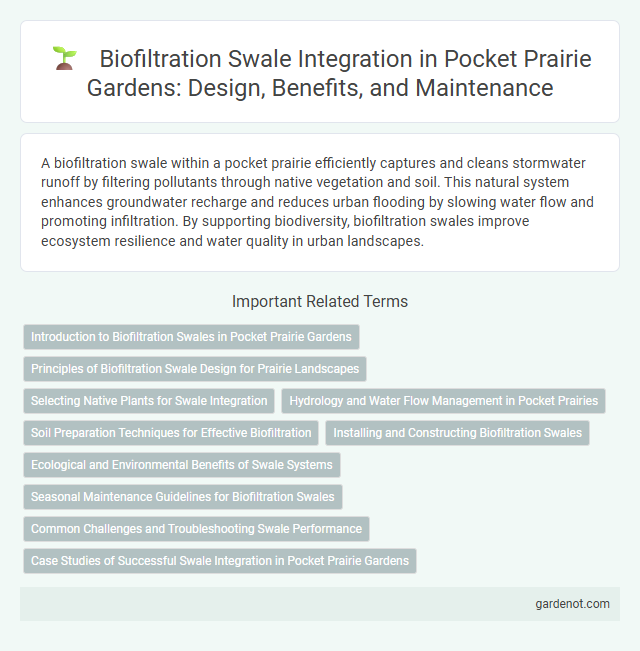A biofiltration swale within a pocket prairie efficiently captures and cleans stormwater runoff by filtering pollutants through native vegetation and soil. This natural system enhances groundwater recharge and reduces urban flooding by slowing water flow and promoting infiltration. By supporting biodiversity, biofiltration swales improve ecosystem resilience and water quality in urban landscapes.
Introduction to Biofiltration Swales in Pocket Prairie Gardens
Biofiltration swales in pocket prairie gardens serve as engineered landscape features designed to manage stormwater runoff while enhancing water quality through natural filtration processes. These swales utilize native prairie plants whose deep root systems increase soil permeability, promoting groundwater recharge and reducing surface pollutants. Integrating biofiltration swales within pocket prairie designs supports sustainable urban water management and biodiversity by mimicking natural hydrological cycles.
Principles of Biofiltration Swale Design for Prairie Landscapes
Biofiltration swale design for prairie landscapes prioritizes natural filtration by integrating native prairie grasses and deep-rooted plants to enhance stormwater infiltration and pollutant removal. Key principles include maintaining gentle slopes for effective water flow, maximizing soil permeability with engineered substrates, and promoting biodiversity to support microbial communities essential for nutrient cycling. Proper swale sizing aligns with watershed area and expected runoff volume, ensuring optimal pollutant capture and groundwater recharge.
Selecting Native Plants for Swale Integration
Selecting native plants for a biofiltration swale enhances water filtration efficiency by leveraging species adapted to local soil and climate conditions. Deep-rooted natives like switchgrass (Panicum virgatum) and blue flag iris (Iris versicolor) improve soil infiltration and pollutant uptake. Integrating diverse native plants supports habitat creation, stabilizes swale banks, and reduces maintenance requirements in pocket prairie systems.
Hydrology and Water Flow Management in Pocket Prairies
Biofiltration swales in pocket prairies effectively manage stormwater by capturing and filtering runoff, reducing pollutant loads before infiltration. These engineered channels enhance hydrology by promoting slow water flow, increasing groundwater recharge, and minimizing surface erosion. Integrating native vegetation within swales optimizes water absorption and supports sustainable urban water cycles.
Soil Preparation Techniques for Effective Biofiltration
Effective soil preparation for biofiltration swales in pocket prairies involves loosening compacted soil to enhance infiltration and root penetration. Incorporating organic matter such as compost or mulch improves soil structure, nutrient availability, and microbial activity critical for pollutant breakdown. Proper grading ensures water flows evenly through the swale, maximizing contaminant removal and preventing erosion.
Installing and Constructing Biofiltration Swales
Installing and constructing biofiltration swales involves excavating shallow, linear depressions lined with permeable soil media rich in organic matter to enhance stormwater infiltration and pollutant removal. Native vegetation such as grasses, sedges, and shrubs is planted to stabilize soil, promote microbial activity, and absorb nutrients, facilitating efficient water filtration. Incorporating underdrains and overflow structures ensures controlled water flow, preventing flooding while maximizing pollutant capture within pocket prairie stormwater management systems.
Ecological and Environmental Benefits of Swale Systems
Biofiltration swales enhance water quality by filtering pollutants and sediments through vegetation and soil media, promoting groundwater recharge and reducing stormwater runoff. These systems support biodiversity by providing habitats for native plants and wildlife, contributing to ecosystem resilience. Swales also mitigate urban heat island effects and improve air quality, reinforcing their role in sustainable landscape management.
Seasonal Maintenance Guidelines for Biofiltration Swales
Seasonal maintenance of biofiltration swales involves regular removal of sediment and debris to maintain optimal water infiltration and pollutant removal efficiency. Inspecting and replacing vegetation during spring and fall ensures root systems remain healthy and effective in stabilizing soil and filtering runoff. Monitoring water flow patterns prevents erosion damage and supports long-term ecological function of the pocket prairie system.
Common Challenges and Troubleshooting Swale Performance
Biofiltration swales in pocket prairies often face challenges such as sediment accumulation, clogging due to excessive organic matter, and poor vegetation establishment that reduces infiltration rates. Regular maintenance involves removing debris, ensuring proper grading to prevent standing water, and selecting native plant species adapted to local hydrological conditions to improve swale performance. Monitoring water flow patterns and soil permeability helps identify and address clogging or erosion issues promptly.
Case Studies of Successful Swale Integration in Pocket Prairie Gardens
Biofiltration swales have been successfully integrated into pocket prairie gardens, enhancing stormwater management by naturally filtering pollutants and promoting groundwater recharge. Case studies highlight improved biodiversity, with native plants thriving and attracting pollinators, while reducing urban runoff in diverse climates. These projects demonstrate the practical benefits of swales for sustainable urban landscaping and ecological restoration.
Biofiltration swale Infographic

 gardenot.com
gardenot.com